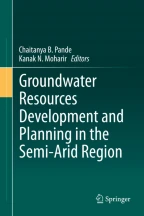
The potential of remote sensing and GIS techniques has long been appreciated in the management of almost every natural resource. Water being one of the most important natural resource, its applications in the field of hydrology are vast. Though geospatial technology has limited applications in the groundwater hydrology, many research works has been carried out. This chapter outlines the different applications of geospatial techniques in groundwater domain. Remotely sensed data and indicators derived from these data for the groundwater are useful in the detailed hydrogeological studies for the zonation of potential groundwater sources, fractured aquifer identification by distinguishing lineaments, artificial groundwater recharge zonation and mapping groundwater in the data scarce regions. RS (Remote Sensing) data with GIS (Geographic Information System) are extensively used for deriving topographical features and geomorphological factors such as elevation, slope, land use, drainage pattern, lithology, geological structures which is essential for identifying potential zones of groundwater sources; also highly useful in identification of alluvial aquifers. Identification of soil types by its spectral signatures from the satellite images can also be utilized for the determination of infiltration capacity of the region. Soil moisture content which is the indicator of the presence of the water in the subsurface strata of the soil or the porous medium can be detected by infrared bands or the thermal bands of optical satellite imagery. So, with less and precise geological investigations, one can estimate the locations of various springs exposing the aquifer. In dry and arid areas where there is less vegetation and dry vadose zone, long wave radar signals can be sometimes used to detect the groundwater table at the depth of few meters or even some paleo or buried channels. In the year 2002, joint venture of the NASA (National Aeronautics and Space Agency), USA and German Aerospace Agency (DLR) have launched GRACE (Gravity Recovery and Climate Experiment) mission.
0Two twin satellites were placed in earth’s orbit to measure the earth’s gravity field anomalies from space. Gravity anomalies represent the general mass distribution around the globe. By measuring the changes in the earth’s mass, one can estimate the volume of water stored in any region. GRACE mission provides long data for analysis. Research studies on GRACE data have been estimated groundwater changes in some of biggest aquifers. These results have been used to govern groundwater usage in the irrigation. Integration of GRACE data with the surface water data and hydrological modelling studies have given estimates of groundwater usage in some of the Indian states also.
Over usage of groundwater can lead to the land subsidence due to the altercation in the clay layers in the soil profile which will ultimately affect the aquifer and shift water table further downwards. The high-tech remote sensing technique of use of the In SAR (Interferometric Synthetic Aperture Radar) data has proven its potential in identifying such land subsidence zones in many research studies. Multitemporal SAR images throughout the long period of time are effective in the zonation of land subsidence. This data with certain ground data have potential to estimate the permanent loss of water storage capacity of the aquifer. Interferometric processing of the SAR images acquired by ERS 1/2, ENVISAT, and Sentinel-1 missions can be utilized for such studies. Groundwater modelling is very complex task as far as data requirements and its preparation is concerned. RS and GIS technology can assist to these tasks to some extent. The numerical groundwater model requires data of time constant and time varying parameters. GIS technology is highly advantageous in preparing data for time constant parameters such as aquifer geometry, land cover, soil surface, river network, subsurface hydrological data input, also various hydraulic parameters. Integration of GIS in groundwater numerical modelling makes things very easy as GIS makes the spatial data according to the model requirements. It is also useful in preparing complex maps for better data visualization. In India, application of RS data in groundwater management has been increased with the advent of the Hydro-geomorphological maps prepared by NRSC (National Remote Sensing Agency). These maps are being used by various other implementing agencies in the management of drinking water resources and water supply schemes.
This is a preview of subscription content, log in via an institution to check access.